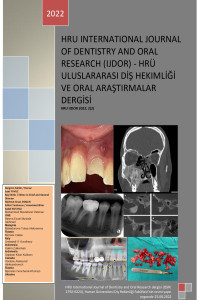Tekli Dişeti Çekilmesinin Bağ Dokusu Destekli Modifiye Tünel Tekniği ile Kapatılması
Tekli Dişeti Çekilmesinin Bağ Dokusu Destekli Modifiye Tünel Tekniği ile Kapatılması
Özet
Bu çalışmanın amacı tekli dişeti çekilmesine sahip hastaya uygulanacak olan bağ dokusu greftinin kök yüzey kapanmasındaki etkinliğinin değerlendirilmesidir. Harran üniversitesi Diş Hekimliği Periodontoloji AB ‘ye başvuran 38 yaşındaki bayan hastanın alt çene sol ikinci keser dişinde Miller Sınıf 2 dişeti çekilmesine rastlanmış ve bağ dokusu grefti destekli modifiye tünel tekniği ile tedavisine karar verilmiştir. Plak indeksi (Pİ), gingival indeks (Gİ), sondalama derinliği (SD), klinik ataşman kaybı (KAK), dişeti çekilme derinliği (DÇ) ve keratinize doku genişliği (KD) gibi periodontal parametreler başlangıçta ve 6. ayda değerlendirilmiştir. Post operatif 6. aydaki kök kapanma miktarı %89 olarak elde edilmiştir. Sonuç olarak dişeti çekilmesinin tedavisinde kullanılan bağ dokusu grefti destekli modifiye tünel tekniği açığa çıkan kök yüzeylerini örtmede başarılı bulunmuştur.
Anahtar kelimler: Bağ dokusu grefti, dişeti çekilmesi, modifiye tünel tekniği
Closure of Single Gingival Recession with Connective Tissue Supported Modified Tunnel Technique
Summary
The aim of this study is to evaluate the effectiveness of the connective tissue graft to be applied to the patient with single gingival recession in root surface closure. Miller Class 2 gingival recession was found in the lower jaw left second incisor of a 38-year-old female patient who reffered to Harran University Dentistry Periodontology Department, and it was decided to treat her with a modified tunnel technique supported by a connective tissue graft. Periodontal parameters such as plaque index (PI), gingival index (GI), probing depth (PD), clinical attachment loss (CAL), gingival recession depth (GR), and keratinized tissue width (KT) were evaluated at baseline and at 6 months. The root closure rate at the 6th postoperative month was 89%. As a result, the connective tissue graft-supported modified tunnel technique used in the treatment of gingival recession was successful in covering the exposed root surfaces.
Keywords: Connective tissue graft, gingival recession, modified tunnel technique
TEKLİ DİŞETİ ÇEKİLMESİNİN BAĞ DOKUSU DESTEKLİ MODİFİYE TÜNEL TEKNİĞİ İLE KAPATILMASI
Tekli Dişeti Çekilmesinin Bağ Dokusu Destekli Modifiye Tünel Tekniği ile Kapatılması
Özet
Bu çalışmanın amacı tekli dişeti çekilmesine sahip hastaya uygulanacak olan bağ dokusu greftinin kök yüzey kapanmasındaki etkinliğinin değerlendirilmesidir. Harran üniversitesi Diş Hekimliği Periodontoloji AB ‘ye başvuran 38 yaşındaki bayan hastanın alt çene sol ikinci keser dişinde Miller Sınıf 2 dişeti çekilmesine rastlanmış ve bağ dokusu grefti destekli modifiye tünel tekniği ile tedavisine karar verilmiştir. Plak indeksi (Pİ), gingival indeks (Gİ), sondalama derinliği (SD), klinik ataşman kaybı (KAK), dişeti çekilme derinliği (DÇ) ve keratinize doku genişliği (KD) gibi periodontal parametreler başlangıçta ve 6. ayda değerlendirilmiştir. Post operatif 6. aydaki kök kapanma miktarı %89 olarak elde edilmiştir. Sonuç olarak dişeti çekilmesinin tedavisinde kullanılan bağ dokusu grefti destekli modifiye tünel tekniği açığa çıkan kök yüzeylerini örtmede başarılı bulunmuştur.
Anahtar kelimler: Bağ dokusu grefti, dişeti çekilmesi, modifiye tünel tekniği
Closure of Single Gingival Recession with Connective Tissue Supported Modified Tunnel Technique
Summary
The aim of this study is to evaluate the effectiveness of the connective tissue graft to be applied to the patient with single gingival recession in root surface closure. Miller Class 2 gingival recession was found in the lower jaw left second incisor of a 38-year-old female patient who reffered to Harran University Dentistry Periodontology Department, and it was decided to treat her with a modified tunnel technique supported by a connective tissue graft. Periodontal parameters such as plaque index (PI), gingival index (GI), probing depth (PD), clinical attachment loss (CAL), gingival recession depth (GR), and keratinized tissue width (KT) were evaluated at baseline and at 6 months. The root closure rate at the 6th postoperative month was 89%. As a result, the connective tissue graft-supported modified tunnel technique used in the treatment of gingival recession was successful in covering the exposed root surfaces.
Keywords: Connective tissue graft, gingival recession, modified tunnel technique
___
- 1. Wennström JL. Mucogingival therapy. Ann Periodontol 1996; 1:671-701.
2. Armitage GC. Development of a classification system for periodontal diseases and conditions. Ann Periodontol 1999; 4:1-6.
- 3. Serino G, Wennström J. The prevelance and distrubution of gingival recession in subjects. J Clin Periodontol 1994; 21:57-63.
- 4. Woofter C. The prevalence and etiology of gingival recession. Periodontal Abstr. 1969 ;17:45-50.
- 5. Chambrone L, Sukekava F, Araújo MG, Pusti- glioni FE, Chambrone LA, Lima LA. Root‐coverage procedures for the treatment of localized recession type defects: A Cochrane systematic review. J Periodontol 2010; 81:452-78.
- 6. Serino G, Wennström J. The prevelance and distrubution of gingival recession in subjects. J Clin Periodontol 1994; 21:57-63.
- 7. Löst C. Depth of alveolar bone dehiscences in relation to gingival recessions. J Clin Periodontol 1984; 11:583-589.
- 8. Ericsson I, Lindhe J. Recession in sites with inadequate width of the keratinized gingiva. An experimental study in dog. J Clin Periodontol 1984; 11:95-103.
- 9. Wennström JL. Mucogingival therapy. Ann Periodontol 1996; 1:671- 701.
- 10. Gorman WL. Prevelance and etiology of gingival recession. J Periodontol 1967; 38:316-22.
